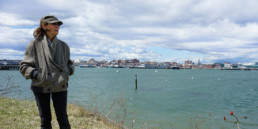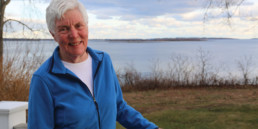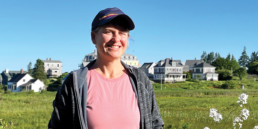Not Aging, But Thriving in Place
Safe housing, healthcare for elderly poses challenges on islands.
BY SUSAN Q. STRANAHAN
PHOTOS BY JIM THRESHER
Victoria Smith was born on Chebeague Island on January 6, 1925, surrounded by her family in the neat frame home now occupied by her son and his wife. When she married an islander, they moved next door. Today, Smith’s granddaughter, grandson-in-law, and two great-grandsons have a home nearby.
Three years ago, when Smith’s health declined and living alone became difficult, she and her family made a choice available to few islanders: She moved about a mile away, into a cozy room at Chebeague’s Island Commons, a seven-bed residential care home created for people exactly like Smith.
Lifelong friends live just down the hall at the Commons. Her extended family drops in daily. Friends stop by. She keeps tabs on the newest generation of Chebeaguers when students from the island’s elementary school arrive for regular visits. Social events and workdays at the Commons attract the whole community. All the while, a team of trained caregivers works 24/7, helping with daily tasks, providing home-cooked meals and companionship, and overseeing the health and well-being of the elderly residents.
Smith is unstinting in her gratitude. “I feel Chebeague is truly blessed to have the Island Commons,” she says.
~
Only recently has eldercare in Maine surfaced as a critical social and economic issue. Demographics drive that urgency. Maine has the highest percentage of older people in the United States, with a third of its population (nearly 420,000 people) above 55. That number will grow by 13 percent in just six years, according to a recent study. In pockets of the state, the median age already is considerably higher. On Chebeague, for example, it is 61, making the town the “grayest” of Maine’s unbridged islands.
Age isn’t the only statistic that makes eldercare a looming problem for government officials, nonprofit organizations, and policy makers. More than a third of Maine’s population is considered low-income. Many of the state’s elderly live in old houses, costly to maintain and heat, and often full of hazards for the frail or those with mobility problems. In rural communities, both on islands and the mainland, access to home care and even basic medical treatment is difficult and undependable, with transportation a major obstacle. Care often falls to family members, many ill-equipped financially or lacking in training.
And then there is the human side of the equation. Elders like Victoria Smith have spent their entire lives sustaining their small communities, raising families, supporting schools, churches, libraries, and volunteer organizations. In their final years, shouldn’t they be able to live amid all that’s familiar, close to family and friends? For many, that’s simply not an option.
Twenty years ago, a small group of Chebeague residents, led by Charlotte “Pommy” Hatfield, recognized the lack of basic health-care services for islanders. Hatfield, a schoolteacher who had cared for her dying husband at home, had been rebuffed by mainland agencies and care providers unwilling to travel to the island. Unwilling to give up, Hatfield and her team came to a conclusion.
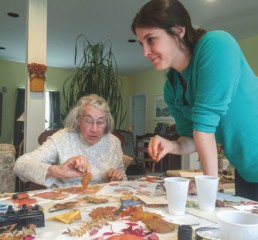
“We should do this ourselves,” she recalled. “We knew nothing, but we just did it.”
Hatfield researched what other regions of the country were doing, and familiarized herself with eldercare and hospice care requirements, eventually working as a care provider herself. What began as an effort to educate islanders about health and aging issues grew as the community members made clear what they wanted to have.
“They wanted comfort and care,” said Hatfield. But there was more: “They wanted to see a familiar face.”
Thus was born the Island Commons. Since it opened its doors in January 1999, the Commons has enabled more than 100 elders to “age in place,” or, to borrow a more up-to-date term of care, “thrive in place.”
An early document set out the ambitious goal: The Island Commons will be a “homey, congenial place where friends, relatives (including children), neighbors, and caregivers can drop in, lend a hand, or share a quiet moment.” A 19th-century farmhouse was donated, renovations undertaken, and fund-raising began in earnest.
From the start, the challenges were enormous—and they remain just as daunting today. Nonstop fund-raising is essential simply to keep the Commons’ doors open.
Typically, about two-thirds of Commons residents are MaineCare (Maine’s name for its Medicaid program) recipients. Yet MaineCare reimbursement rates fail to cover the cost of delivering care by about $20,000 per person per year. And, given the small size of the facility and its remote location, even the most cost-conscious administrator is unable to achieve economies of scale available to larger mainland counterparts.
Facilities like the Commons also operate in a highly regulated environment, with rules governing everything from the temperature of food in the refrigerator to the licensing of caregivers. Unlike other island nonprofits, the lights never go off at the Commons. Finding, training, and retaining staff to operate the facility round-the-clock can prove difficult.
But such challenges have not deterred other island communities from responding in their own ways to the needs of their elderly populations. Those services include the residential facilities Boardman Cottage on Islesboro and the Ivan Calderwood Home on Vinalhaven, with plans for a facility on North Haven in the works.
Maine Seacoast Mission, which has long provided health-care services in Penobscot Bay, is expanding its eldercare offerings. On Swan’s Island, Eldercare Outreach offers a variety of services for elderly residents, intended to enable them to remain in their own homes for as long as possible. The Island Commons also recently added in-home care to its services through Chebeague Cares.
In many respects, this is new territory for health-care providers, regulators, volunteer board members, and facility administrators, in part because of the unique nature of each location and its needs. To share common experiences, an informal network of providers has formed to discuss problems and explore new services. (Many of the solutions being tried by island eldercare providers also have applications elsewhere, notably in Maine’s rural and Native American communities.)
The island eldercare network also has demonstrated that there can be strength in numbers. Last year, the Maine Legislature approved a 15 percent increase in MaineCare subsidies for the Commons, Boardman Cottage, and Ivan Calderwood, recognizing that offshore locations drive up the cost of food and fuel, further straining the low subsidies. The increase came after testimony from island eldercare administrators about the importance of their services and their dire financial needs. The total outlay of state funds is small—about $26,000 annually—but the acknowledgment of the special circumstances was welcomed.
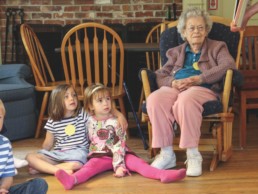
All who are involved in this growing response share a common goal: keeping island elders in their communities. “This is what they know,” said Amy Rich, administrator at the Commons. “This is where their roots are, where their families are, and this is where they want to stay.”
To make that possible, they may require modest services such as light housekeeping and meal preparation, or their needs might rise to the level of skilled nursing or hospice care. The advancing ages and declining health of many islanders pose their own set of challenges to the care providers that go far beyond the financial pressures of day-to-day operations.
~
It’s late afternoon and Jen Belesca is sitting at her grandmother’s bedside, massaging Victoria Smith’s hands. The warm yellow bedroom, with chintz curtains and comfortable pillows, is full of family photos and mementos. From the hallway, the aroma of dinner fills the air.
Belesca stops in daily to keep “Grammy Toe,” as Smith is known to her family, company. Belesca’s sons, Ethan, 15, and Aaron, 14, often ride their bikes over to pay a call.
“She’s right here,” says Ethan of his great-grandmother. During last year’s Fourth of July Road Race, he even stopped by to grab a glass of water and say “Hi” to her before resuming the race. Family members visit at meals and bedtime to assist Smith and keep her up-to-date on island news.
Those routine visits would be difficult if Smith were in a mainland nursing home. (Long before the Commons opened, Smith’s own mother spent four years in a mainland nursing home, an experience the family never wants to repeat.) Now, Smith is just minutes away. The value of having her so close is apparent to everyone. “When the Commons came into being, it was one of the best things that ever happened to Chebeague,” said her son, Lindy Smith. “I thought then it was a great idea—but I didn’t realize how important it would become to this island.”

